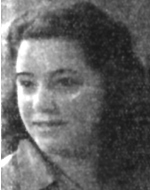Daughter of Mina and Zvi, was born on August 8, 2727 in the town of Lofetz, Belorussia. In 1934 the family immigrated to Israel and settled in Rishon Lezion. After completing her studies at the elementary school in Bilu, Bilha continued her studies at the Herzliya Gymnasium in Tel Aviv, where she traveled every day. After completing her studies, Bilha enlisted for a year of service in the Palmach in 1944-1945, as part of the core of the Maccabee Youth Training Center in Ramat David, a typical expression of the willpower, dedication and perseverance that characterized Bilha. In the Galilee Mountains along a route between hostile Arab villages On October 9, 1945, Bilha took part in an operation by the Palmach to free the Ma’apilim from the Atlit detention camp. When Bil’in decided to immigrate to Israel, Bilha decided to leave the core and enrolled in pedagogy and psychology at the Hebrew University of Jerusalem in order to fulfill her desire to engage in educational work to help troubled youth and marginalized youth. She spent her summer vacation studying with love for the company, and during the course of her studies she acquired friends and loved ones whom she loved and cherished, and during her studies she wrote a number of research papers on abandoned and problematic youth. Bilha stabilized During the war, Bilha volunteered to serve in the “Tzuba” quarry, where she worked as a courier, combatant, and paramedic, describing Bilha’s last days as described in the book “Nine Cabins” by Yitzhak Levi (Levitza) and by Joseph Shivman arrived at the quarries of Tzuba at the end of February 1948. “On March 1, 1948, the situation worsened, the shooting of the Arabs did not stop, and the lives of the soldiers were in constant danger. On April 1, 1948, the Arabs attacked the force in the quarry with strong fire. The shots continued unabated day and night. One day the Arabs managed to approach the quarry a few meters away and demanded that the fighters surrender. After five days of fighting without food and without sleep, and when the situation worsened, Yosef Schiffman ordered the soldiers to open the tower and the surrounding area and to retreat to the “Arza” recovery home in Motza (5.4.1948). The platoon left the quarry and the minefields it had planted, causing great killing among the Arabs who took control of the quarry. In Arza, families and children of elite and “Aryza” families crowded together, as well as wounded soldiers, tired and exhausted after days of fighting, days and nights without sleep and food. After the conquest of the village of Kolonia, which blocked the road to Jerusalem (now Mevasseret Zion, which is parallel to Motza Ilit), it was decided to transfer the soldiers and civilians, including Bilha, to Jerusalem. On April 6, 1948, the convoy left at 6 AM and encountered many roadblocks scattered on the road and fire from the Arab outposts on the hills. Despite the fierce fire and the roadblocks on the way, the convoy continued on its way. “The third convoy from Jerusalem was attacked by fire, and the armored vehicle Bilha was riding in fell off the road and fell to a depth of 100 meters, most of the people in the armored vehicle were injured, some were killed, Bilha was wounded. Since access to the wounded was difficult, Bilha mounted herself up the mountain. ” Bilha was brought to Shaare Zedek Hospital, and two days later, on the 29th of Adar II 5708 (1948), she died. She was buried in Sanhedria in Jerusalem. Survived by parents, two sisters and two brothers. On the 5th of Elul 5711 (September 6, 1951), she was transferred to eternal rest in Beit HakavRuth military base at Mount Herzl.
